Reliability of Morphological and PCR Methods for the Official Diagnosis of Aethina tumida (Coleoptera: Nitidulidae): A European Inter-Laboratory Comparison
Abstract
Simple Summary
Abstract
1. Introduction
2. Materials and Methods
2.1. Participating Laboratories
2.2. Reference Methods for Panel Sample Characterisation
2.3. Selection of Inter-Comparison Samples
- The fact that the coleopteran species belong to the Nitidulidae family (i.e., same family as A. tumida), and therefore have similar morphological and molecular characteristics, and/or,
- The fact that the species were likely to be found in the honeybee hive environment, and/or,
- The fact that the species presented morphological features close to A. tumida, and,
- The availability of specimens in sufficient numbers to constitute the panels and to carry out homogeneity and stability tests.
2.4. Homogeneity and Stability Tests
- The specimens from batches A-POS, A-NEG1, L-NEG1, A-NEG4 were produced artificially in a controlled environment;
- The specimens from batches L-NEG3 and A-NEG3 were provided and previously analysed by specialised entomologists;
- The EURL produced the G. mellonella larvae (L-NEG2) artificially from combs coming from the ANSES apiary in Sophia-Antipolis (territory officially free from A. tumida at sampling date in 2019);
- The results of the homogeneity tests of a preliminary study carried out in 2018 were satisfactory for A. tumida specimens (A-POS) and T. molitor specimens (A-NEG1 and L-NEG1), of the same origin;
- The specimens were visually controlled when the tubes were prepared.
2.5. Process for the Interlaboratory Comparison
- Sensitivity, i.e., the ability of the laboratory to give a positive result for a positive sample [30];
- Specificity, i.e., the ability of the laboratory to give a negative result for a negative sample [30];
- Accuracy, i.e., the closeness of agreement between the obtained results and the assigned values, definition adapted from international standard NF EN ISO 16140 [31].
2.6. Results Evaluation
2.7. Information on Analytical Methods Employed by the Participants
3. Results
3.1. Individual Laboratory Performance for the Morphological Identification of A. tumida
3.2. Individual Laboratory Performance for PCR Identification of A. tumida
3.3. Individual Laboratory Performance for Expressing Opinions
3.4. Overall Performance of the Participants
3.5. Performance of the Methods Used for the Official Diagnosis of A. tumida
4. Discussion
5. Conclusions
Author Contributions
Funding
Institutional Review Board Statement
Acknowledgments
Conflicts of Interest
Appendix A. Information on Homogeneity Tests
| Code | Species | Number of Samples Prepared | Number of Samples Tested | Results |
|---|---|---|---|---|
| A-POS | Aethina tumida | 115 | 10 | 100% Pos. |
| A-NEG1 | Tenebrio molitor | 60 | 7 | 100% Neg. |
| A-NEG2 | Alphitobius diaperinus | 60 | 10 | 100% Neg. |
| A-NEG3 | Epuraea luteola | 50 | 5 | 100% Neg. |
| A-NEG4 | Cryptolaemus montrouzieri | 60 | 7 | 100% Neg. |
| L-POS | Aethina tumida | 115 | 10 | 100% Pos. |
| L-NEG1 | Tenebrio molitor | 75 | 7 | 100% Neg. |
| L-NEG2 | Galleria mellonella | 60 | 7 | 100% Neg. |
| L-NEG3 | Carpophilus dimidiatus | 60 | 7 | 100% Neg. |
Appendix B. Scoring Individual Performance
| Step 1–Scoring of Each Single Results, According to the Following Process | |
| Score of “0” | Results that matched the assigned values exactly:
|
| Score of “1” | Results that did not match the assigned values exactly:
|
| Score of “2” | Results that did not match the assigned values:
|
| Step 2–Assessment of the three criteria for individual performance | |
| Sensitivity | Sum of the scores obtained for all the positive samples of the panel. |
| Specificity | Sum of the scores obtained for all the negative samples of the panel. |
| Accuracy | Sum of the scores obtained for all the samples of the panel (positive and negative). |
| Step 3–Final performance evaluation | |
For each performance criterion:
| |
Appendix C. Detailed Results of the Participants
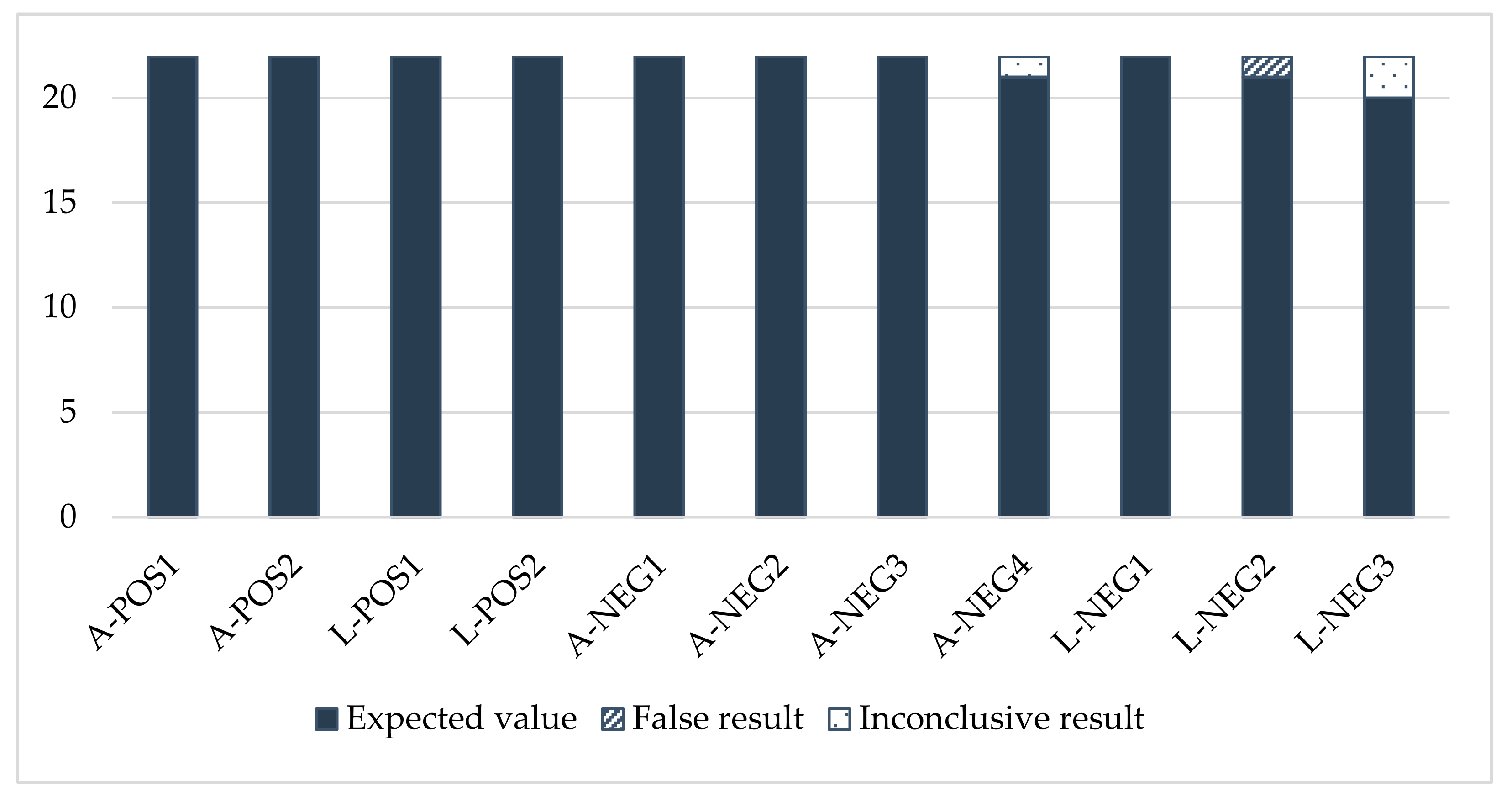
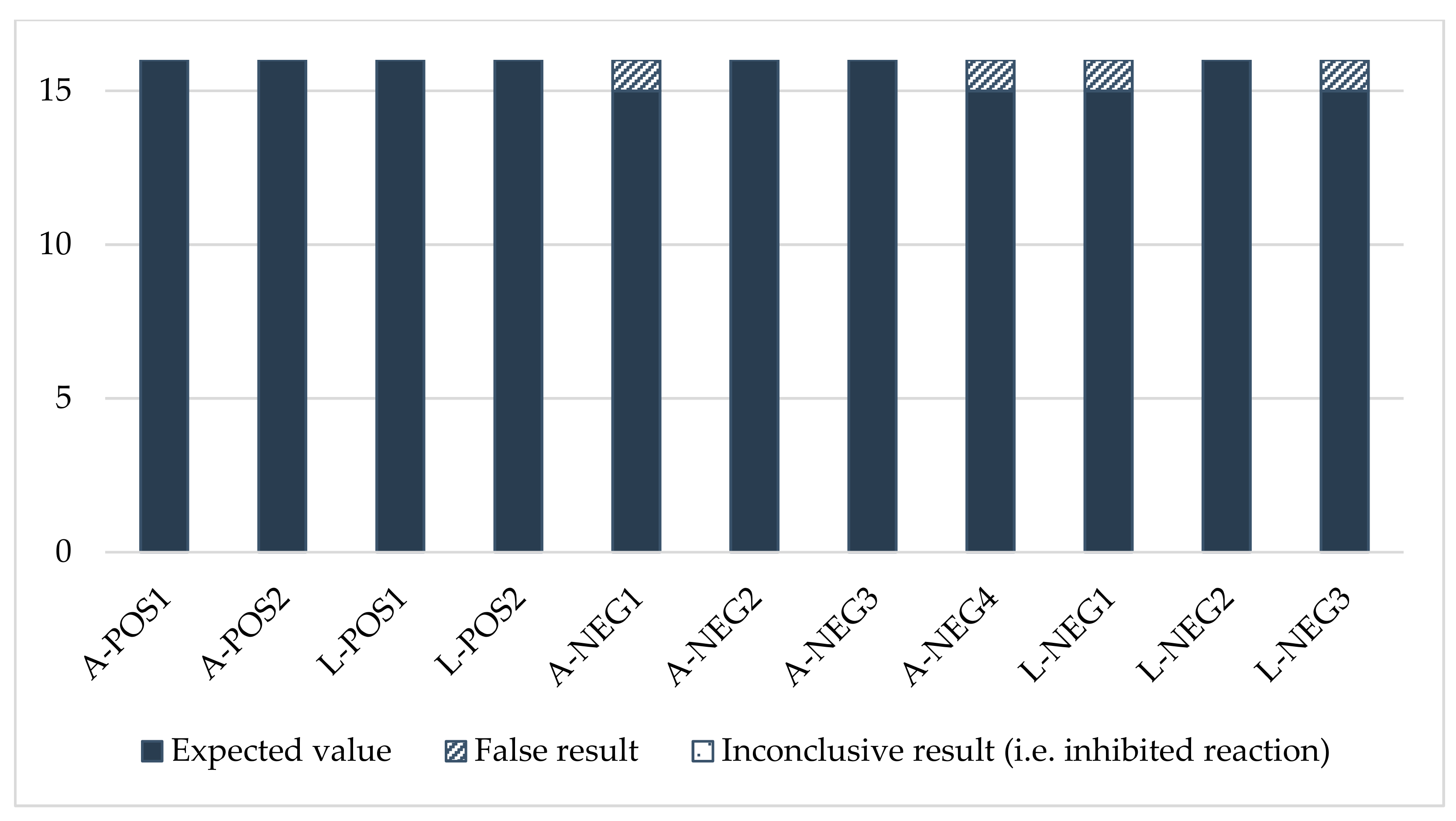
| Morphology | PCR | |||||
|---|---|---|---|---|---|---|
| Lab Code | Acc 1 | Se 2 | Sp 3 | Acc 1 | Se 2 | Sp 3 |
| 1 | 0 | 0 | 0 | 0 | 0 | 0 |
| 2 | 0 | 0 | 0 | 0 | 0 | 0 |
| 3 | 0 | 0 | 0 | 0 | 0 | 0 |
| 4 | 0 | 0 | 0 | 0 | 0 | 0 |
| 5 | 0 | 0 | 0 | 0 | 0 | 0 |
| 6 | 1 | 0 | 1 | 0 | 0 | 0 |
| 7 | 0 | 0 | 0 | NP | NP | NP |
| 8 | 0 | 0 | 0 | NP | NP | NP |
| 9 | 0 | 0 | 0 | 0 | 0 | 0 |
| 10 | 0 | 0 | 0 | 0 | 0 | 0 |
| 11 | 2 | 0 | 2 | 8 | 0 | 8 |
| 12 | 0 | 0 | 0 | NP | NP | NP |
| 13 | 0 | 0 | 0 | 0 | 0 | 0 |
| 14 | 0 | 0 | 0 | 0 | 0 | 0 |
| 15 | 0 | 0 | 0 | 0 | 0 | 0 |
| 16 | 0 | 0 | 0 | 0 | 0 | 0 |
| 17 | 0 | 0 | 0 | NP | NP | NP |
| 18 | 0 | 0 | 0 | 0 | 0 | 0 |
| 19 | 0 | 0 | 0 | 0 | 0 | 0 |
| 20 | 0 | 0 | 0 | NP | NP | NP |
| 21 | 0 | 0 | 0 | 0 | 0 | 0 |
| 22 | 0 | 0 | 0 | NP | NP | NP |
Appendix D. Members of the ILC Consortium
| Name | Institute | |
|---|---|---|
| Rosen Aleksandrov | National Diagnostic and Research Veterinary Medical Institute, Aquaculture, Fish and Bee Diseases, NRL for Bee Diseases, 1040 Sofia, Bulgaria | rosen_angelov1989@abv.bg |
| Gabriela Chioveanu | Institute for Diagnosis and Animal Health, NRL for Animal Health, 50557 Bucharest, Romania | gabriela.chioveanu@idah.ro |
| Mary Coffey | Department of Agriculture, Food and the Marine, Plant Health Laboratories, W23 X3PH Celbridge, Ireland | MaryF.Coffey@agriculture.gov.ie |
| Benjamin Dainat | Agroscope Liebefeld, Swiss Bee Research Centre, 3003 Bern, Switzerland | benjamin.dainat@agroscope.admin.ch |
| María Pilar Fernández Somalo | Laboratorio Central de Veterinaria, Ministerio de Agricultura, Pesca y Alimentación (Gobierno de España), D.G. Sanidad de la Producción Primaria, S.D.G. Sanidad e Higiene Animal y Trazabilidad, 28110 Algete (Madrid), Spain | mfsomalo@mapa.es |
| Miriam Filipova | Department of Molecular Biology and Epizootiology, Veterinary and Food Institute in Dolny Kubin, State Veterinary and Food Institute, NRL for Honeybee Health, 026 01 Dolny Kubin, Slovakia | miriam.filipova@svpu.sk |
| Heather Graham | Wageningen Bioveterinary Research, Wageningen University and Research, NRL for Bee Diseases, 8221 RA Lelystad, The Netherlands | heather.graham@wur.nl |
| Anna Granato | Istituto Zooprofilattico Sperimentale delle Venezie, NRL for Honey Bee Health, 35020 Legnaro (PD), Italy | agranato@izsvenezie.it |
| Sirpa Heinikainen | Kuopio laboratory, Veterinary Bacteriology and Pathology Unit, Laboratory and Research Division, Finnish Food Authority, 70210 Kuopio, Finland | sirpa.heinikainen@ruokavirasto.fi |
| Hemma Köglberger | Department for Apiculture and Bee protection, Ages-Austrian Agency for Health and Food Safety, 1220 Vienna, Austria | hemma.koeglberger@ages.at |
| Nóra Krejczinger | National Food Chain Safety Office, Food Chain Safety Laboratory Directorate, NRL of Parasitology, Fish and Bee Diseases, 1095 Budapest, Hungary | krnori@gmail.com |
| Merle Kuus | Veterinary and Food Laboratory, 51006 Tartu, Estonia | merle.kuus@vetlab.ee |
| Severine Matthijs | Sciensano, Enzootic, Vector-borne and Bee Diseases, 1180 Brussels, Belgium | severine.matthijs@sciensano.be |
| Konstantinos Oureilidis | Veterinary Laboratory of Kavala, Directorate of Veterinary Center of Thessaloniki, Ministry of Rural Development and Food, 64012 Kavala, Greece | ktekav@yahoo.gr |
| Zanda Ozolina | Parasitology group, Laboratory of Microbiology and Pathology, Institute of Food Safety, Animal Health and Environment “BIOR”, LV-1076, Riga, Latvia | zanda.ozolina@bior.lv |
| Metka Pislak Ocepek | National Veterinary Institute, Veterinary Faculty, University of Ljubljana, Laboratory for Bee Health Care, Gerbičeva 60, 1000 Ljubljana, Slovenia | metka.pislakocepek@vf.uni-lj.si |
| Marc Oliver Schäfer | Friedrich Loeffler Institut-Germany, NRL for Bee Diseases, 17493 Greifswald-Insel Riems, Germany | marc.schaefer@fli.de |
| Emilia Semberg | Swedish University of Agricultural Sciences, Ecology, NRL for Honey Bee Health, 75007 Uppsala, Sweden | emilia.semberg@slu.se |
| Ivana Tlak Gajger | Laboratory for Honeybee Diseases APISlab, Department for Biology and Pathology of Fish and Bees, Faculty of Veterinary Medicine, University of Zagreb, 10 000 Zagreb, Croatia | ivana.tlak@vef.hr |
| Maria José Valério | Patologia Apícola, Patologia, Instituto Nacional de Investigacao Agraria e Veterinaria, I. P., 2780-157 Oeiras, Portugal | mjose.valerio@iniav.pt |
| Sarka Vyroubalova | Department of Pathological Morphology, State Veterinary Institute Olomouc, NRL for Honeybee Health, 77900 Olomouc, Czech Republic | svyroubalova@svuol.cz |
References
- Lundie, A.E. The small hive beetle Aethina tumida. Sci. Bull. 1940, 220, 30. [Google Scholar]
- Cuthbertson, A.G.S.; Wakefield, M.E.; Powell, M.E.; Marris, G.; Anderson, H.; Budge, G.E.; Mathers, J.J.; Blackburn, L.F.; Brown, M.A. The small hive beetle Aethina tumida: A review of its biology and control measures. Curr. Zool. 2013, 59, 644–653. [Google Scholar] [CrossRef]
- European Food Safety Authority (EFSA-Panel on Animal Health and Animal Welfare). Survival, spread and establishment of the small hive beetle (Aethina tumida). EFSA J. 2015, 13, 4328. [Google Scholar] [CrossRef][Green Version]
- Gonthier, J.; Papach, A.; Straub, L.; Campbell, J.; Williams, G.; Neumann, P. Bees and flowers: How to feed an invasive beetle species. Ecol. Evol. 2019, 9, 6422–6432. [Google Scholar] [CrossRef]
- Buchholz, S.; Schäfer, M.O.; Spiewok, S.; Pettis, J.S.; Duncan, M.; Ritter, W.; Spooner-Hart, R.; Neumann, P. Alternative food sources of Aethina tumida (Coleoptera: Nitidulidae). J. Apic. Res. 2008, 47, 202–209. [Google Scholar] [CrossRef]
- Neumann, P.; Pettis, J.S.; Schäfer, M.O. Quo vadis Aethina tumida? Biology and control of small hive beetles. Apidologie 2016, 47, 427–466. [Google Scholar] [CrossRef]
- World Organisation for Animal Health (OIE). Infestation with Aethina tumida (Small Hive Beetle). In Manual of Diagnostic Tests and Vaccines for Terrestrial Animals, 9th ed.; OIE: Paris, France, 2019; pp. 750–764. [Google Scholar]
- Mutinelli, F. The spread of pathogens through trade in honey bees and their products (including queen bees and semen): Overview and recent developments. OIE Rev. Sci. Tech. 2011, 30, 257–271. [Google Scholar] [CrossRef] [PubMed]
- Idrissou, F.O.; Huang, Q.; Yañez, O.; Neumann, P. International beeswax trade facilitates small hive beetle invasions. Sci. Rep. 2019, 9, 10665. [Google Scholar] [CrossRef] [PubMed]
- World Organisation for Animal Health (OIE). Infestation with Aethina tumida (Small Hive Beetle). In Terrestrial Animal Health Code; OIE: Paris, France, 2019; Volume 2, pp. 1–6. [Google Scholar]
- Murilhas, A. Aethina tumida arrives in Portugal. Will it be eradicated? EurBee Newsl. 2005, 2, 7–9. [Google Scholar]
- Valerio da Silva, M.J. The first report of Aethina tumida in the European Union, Portugal, 2004. Bee World 2014, 91, 90–91. [Google Scholar] [CrossRef]
- Mutinelli, F.; Montarsi, F.; Federico, G.; Granato, A.; Ponti, A.M.; Grandinetti, G.; Ferré, N.; Franco, S.; Duquesne, V.; Riviere, M.P.; et al. Detection of Aethina tumida Murray (Coleoptera: Nitidulidae.) in Italy: Outbreaks and early reaction measures. J. Apic. Res. 2014, 53, 569–575. [Google Scholar] [CrossRef]
- Palmeri, V.; Scirtò, G.; Malacrinò, A.; Laudani, F.; Campolo, O. A scientific note on a new pest for European honeybees: First report of small hive beetle Aethina tumida (Coleoptera: Nitidulidae) in Italy. Apidologie 2015, 46, 527–529. [Google Scholar] [CrossRef]
- Istituto Zooprofilattico Sperimentale delle Venezie (IZSV). Aethina tumida in Italy: Updates. Available online: https://www.izsvenezie.it/aethina-tumida-in-italia/ (accessed on 17 June 2021).
- European Commission. Commission implementing regulation (EU) 2018/1882 of 3 December 2018 on the application of certain disease prevention and control rules to categories of listed diseases and establishing a list of species and groups of species posing a considerable risk for the spread of those listed diseases. Off. J. Eur. Union 2018, 61, 21–29. [Google Scholar]
- European Commission. Regulation (EU) 2016/429 of the European Parliament and of the Council of 9 March 2016 on transmissible animal diseases and amending and repealing certain acts in the area of animal health (“Animal Health Law”). Off. J. Eur. Union 2016, 59, 1–208. [Google Scholar]
- European Reference Laboratory for Bee Health (EURL); Chauzat, M.-P.; Laurent, M.; Brown, M.; Kryger, P.; Mutinelli, F.; Roelandt, S.; Roels, S.; van der Stede, Y.; Schäfer, M.O.; et al. Guidelines for the Surveillance of the Small Hive Beetle (Aethina tumida) Infestation. Updated Version (April 2016). Available online: https://sitesv2.anses.fr/en/system/files/Guidelines_SHB_surveillance_EURL_V2.pdf (accessed on 19 April 2021).
- Ward, L.; Brown, M.; Neumann, P.; Wilkins, S.; Pettis, J.; Boonham, N. A DNA method for screening hive debris for the presence of small hive beetle (Aethina tumida). Apidologie 2007, 38, 272–280. [Google Scholar] [CrossRef]
- Neumann, P.; Ritter, W. A scientific note on the association of Cychramus luteus (Coleoptera: Nitidulidae) with honeybee (Apis mellifera) colonies. Apidologie 2004, 35, 665–666. [Google Scholar] [CrossRef][Green Version]
- Marini, F.; Mutinelli, F.; Montarsi, F.; Cline, A.R.; Gatti, E.; Audisio, P. First report in Italy of the dusky sap beetle, Carpophilus lugubris, a new potential pest for Europe. J. Pest Sci. 2013, 86, 157–160. [Google Scholar] [CrossRef]
- Ellis, J.D.; Graham, J.R.; Mortensen, A. Standard methods for wax moth research. J. Apic. Res. 2013, 52, 1–17. [Google Scholar] [CrossRef]
- European Reference Laboratory for Bee Health (EURL). Analytical Method for Animal Health, ANSES/SOP/ANA-I1.MOA.1500, Version 04: “Morphological Identification of the Small Hive Beetle (OIE Method)”. Available online: https://sitesv2.anses.fr/en/system/files/Protocol_Instructions_SHB_morphological_Id_2.pdf (accessed on 15 June 2021).
- European Reference Laboratory for Bee Health (EURL). Analytical Method for Animal Health, ANSES/SOP/ANA-I1.MOA.3700, Version 02: “Identification of the Small Hive Beetle Aethina tumida, Using Real Time PCR (In-House Method)”. Available online: https://sitesv2.anses.fr/en/system/files/Protocol_Instructions_SHB_real-time_PCR_2.pdf (accessed on 15 June 2021).
- International Organization for Standardization (ISO-ISO/CASCO Technical Committee on Conformity Assessment). ISO/IEC 17025: 2017 International Standard on General Requirements for the Competence of Testing and Calibration Laboratories. ISO, Switzerland, 2017. Available online: https://www.iso.org/standard/66912.html (accessed on 28 December 2021).
- Folmer, O.; Black, M.; Hoeh, W.; Lutz, R.; Vrijenhoek, R. DNA primers for amplification of mitochondrial cytochrome c oxidase subunit I from diverse metazoan invertebrates. Mol. Mar. Biol. Biotechnol. 1994, 3, 294–299. [Google Scholar] [PubMed]
- International Organization for Standardization (ISO-ISO/TC69/SC6 Technical Committee on Measurement Methods and Results). ISO 13528:2015 International Standard on Statistical Methods for Use in Proficiency Testing by Interlaboratory Comparison. ISO, Switzerland, 2015. Available online: https://www.iso.org/standard/56125.html (accessed on 28 December 2021).
- International Laboratory Accreditation Cooperation (ILAC-Proficiency Testing Consultative Group, Task Force on H&S Testing). ILAC Discussion Paper on Homogeneity and Stability Testing. ILAC, Australia, 2000. Available online: https://www.academia.edu/27733690/ILAC_Discussion_Paper_on_Homogeneity_and_Stability_Testing (accessed on 15 June 2021).
- International Organization for Standardization (ISO-ISO/CASCO Technical Committee on Conformity Assessment). ISO/IEC 17043:2010 International Standard on Conformity Assessment-General Requirements for Proficiency Testing. ISO, Switzerland, 2010. Available online: https://www.iso.org/standard/29366.html (accessed on 28 December 2021).
- International Organization for Standardization (ISO-ISO/TC34/SC9 Microbiology Technical Committee). NF EN ISO 22117:2019 International Standard on Microbiology of the Food Chain-Specific Requirements and Guidance for Proficiency Testing by Interlaboratory Comparison. ISO, Switzerland, 2019. Available online: https://www.iso.org/standard/67052.html (accessed on 28 December 2021).
- International Organization for Standardization (ISO-ISO/TC34/SC9 Microbiology Technical Committee). ISO 16140-1:2016 International Standard on Microbiology of the Food Chain-Method Validation-Part 1: Vocabulary. ISO, Switzerland, 2016. Available online: https://www.iso.org/standard/54869.html (accessed on 15 June 2021).
- Silacci, P.; Biolley, C.; Jud, C.; Charrière, J.-D.; Dainat, B. An improved DNA method to unambiguously detect small hive beetle Aethina tumida, an invasive pest of honeybee colonies. Pest Manag. Sci. 2018, 74, 2667–2670. [Google Scholar] [CrossRef]
- World Organisation for Animal Health (OIE). Animal Health Surveillance. In Terrestrial Animal Health Code, 28th ed.; OIE: Paris, France, 2019; pp. 1–10. [Google Scholar]
- Dufour, B.; Hendrikx, P.; Toma, B. The design and establishment of epidemiological surveillance systems for high-risk diseases in developed countries. Rev. Sci. Et Tech. (Int. Off. Epizoot.) 2006, 25, 187–198. [Google Scholar] [CrossRef] [PubMed]
- World Organisation for Animal Health (OIE). Principles and methods of validation of diagnostic assays for infectious diseases. In Manual of Diagnostic Tests and Vaccines for Terrestrial Animals, 9th ed.; OIE: Paris, France, 2019; pp. 11–22. [Google Scholar]
- Rozet, E.; Dewé, W.; Ziemons, E.; Bouklouze, A.; Boulanger, B.; Hubert, P. Methodologies for the transfer of analytical methods: A review. J. Chromatog. B 2009, 877, 2214–2223. [Google Scholar] [CrossRef]
- Lee, S.; Hong, K.-J.; Cho, Y.S.; Choi, Y.S.; Yoo, M.-S.; Lee, S. Review of the subgenus Aethina Erichson s. str. (Coleoptera: Nitidulidae: Nitidulinae) in Korea, reporting recent invasion of small hive beetle, Aethina tumida. J. Asia Pac. Entomol. 2017, 20, 553–558. [Google Scholar] [CrossRef]
- World Organisation for Animal Health (OIE). Collection, submission and storage of diagnostic specimens. In Manual of Diagnostic Tests and Vaccines for Terrestrial Animals, 9th ed.; OIE: Paris, France, 2019; pp. 72–87. [Google Scholar]
- European Food Safety Authority (EFSA). EFSA scientific report on small hive beetle diagnosis and risk reduction options. EFSA J. 2015, 13, 4048. [Google Scholar] [CrossRef]
- Chabirand, A.; Anthoine, G.; Pierson, O.; Hostachy, B. The organization of proficiency testing in plant pathology (qualitative methods of analysis) according to the ISO/IEC 17043: Example of the French national reference laboratory. Accredit. Qual. Assur. 2014, 19, 111–125. [Google Scholar] [CrossRef][Green Version]
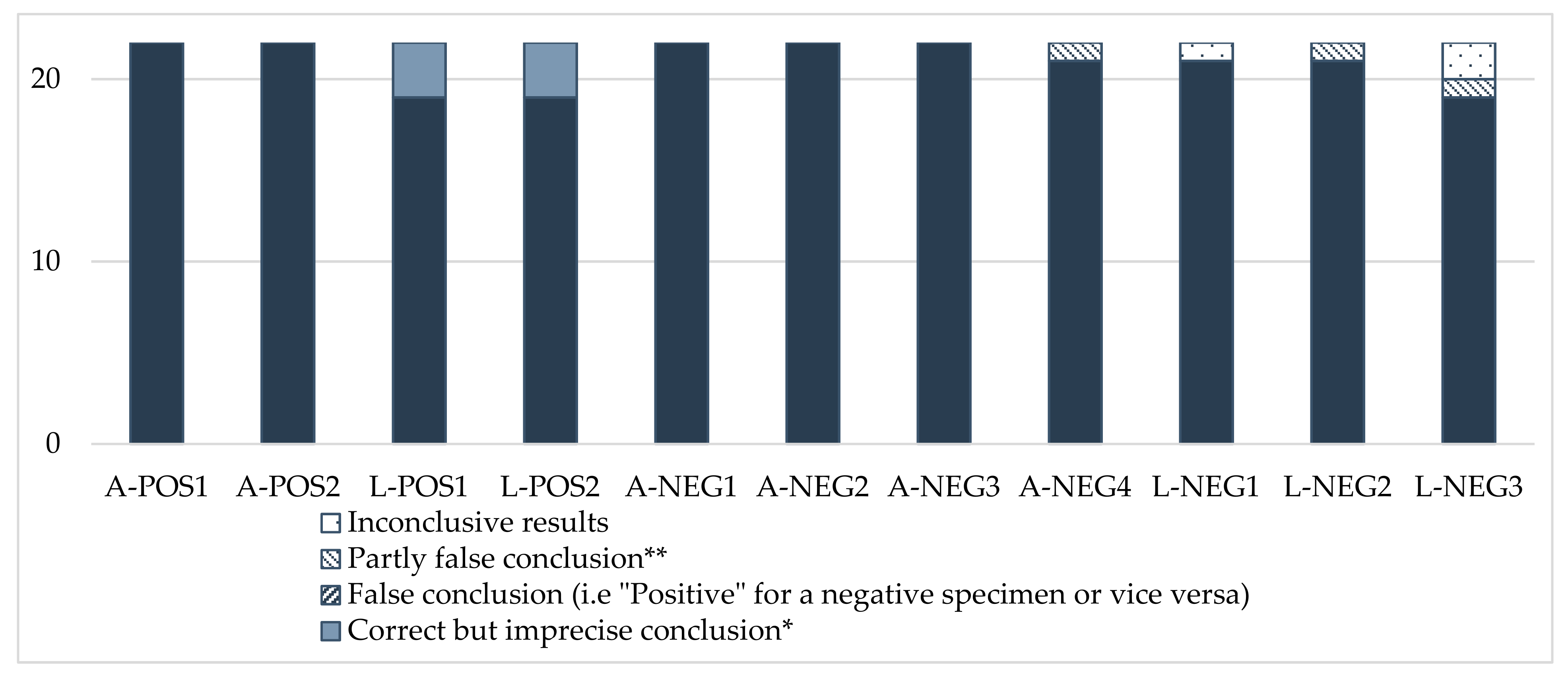
| Criteria | Adult Form |
|---|---|
| 1 | Body divided into three parts: head, thorax and abdomen. |
| 2 | Three pairs of legs. |
| 3 | Presence of elytra 1. |
| 4 | Elytra not covering the entire abdomen: some abdominal segments are apparent in dorsal view. |
| 5 | Overall uniform body colour (no spots), light brown to black 2. |
| 6 | Antenna tips with compact, almost rounded club ends. The three terminal articles of the antennae, corresponding to the “clubs” 3, are narrowed between them, and their length is almost equal to their width. |
| 7 | Sharp latero-posterior tips of the pronotum 4. |
| 8 | Dimensions. Length: 4 to 7 mm (±1 mm). Width: 3 mm (±1 mm). |
| Larval form | |
| 1 | Three pairs of legs, one on each of the anterior segments, corresponding to the larva thorax. |
| 2 | All of the abdominal segments are bare and have no false legs (also called pseudopods) on their ventral part. |
| 3 | From the mesothorax 5, presence on each segment, of two dorsal tubercles on either side of the midline. These tubercles are finished with a short fine seta. They look like “spines”. |
| Sample Code | Species | Origin | Criteria Evaluated | ||
|---|---|---|---|---|---|
| ADULTS | |||||
| A-POS | Aethina tumida (Murray, 1867) | 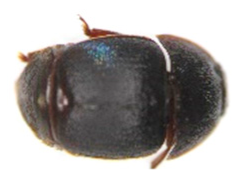 | Coleoptera Nitidulidae Nitidulinae | Specimens obtained experimentally in the confined laboratory of Fera Science, Ltd. in 2019 | Se, Ac |
| A-NEG1 | Tenebrio molitor (Linnaeus, 1758) “Mealworm Beetle” | 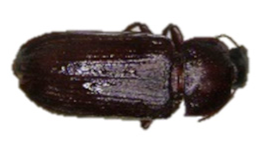 | Coleoptera Tenebrionidae Tenebrioninae | Specimens obtained in 2018 by the company MICRONUTRIS providing insects for human consumption | Sp, Ac |
| A-NEG2 | Alphitobius diaperinus (Panzer, 1797) | 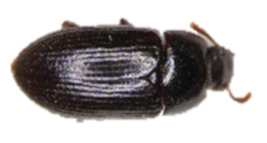 | Coleoptera Tenebrionidae Tenebrioninae | Specimens collected in 2018 on the frame lid of honeybee hives located near a rabbit farm in Vendée (France) | Sp, Ac |
| A-NEG3 | Epuraea luteola (Erichson, 1843) | 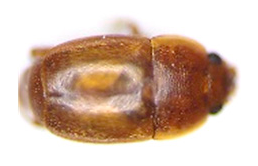 | Coleoptera Nitidulidae Epuraeinae | Specimens collected in 2018 on Citrus sinensis in Corsica (France) and provided by the Plant Health Laboratory (ANSES, Montpellier, France) | Sp, Ac |
| A-NEG4 | Cryptolaemus montrouzieri (Mulsant, 1853) “Ladybug” | 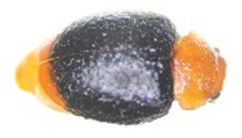 | Coleoptera Coccinellidae Coccinellidae | Specimens obtained in 2019 by the company BIOLINE AGROSCIENCES providing insects for biological control in the plant field | Sp, Ac |
| LARVAE | |||||
| L-POS | Aethina tumida (Murray, 1867) |  | Coleoptera Nitidulidae Nitidulinae | Specimens collected in 2013 in Maryland (United States) and provided by J.S. Pettis | Se, Ac |
| L-NEG1 | Tenebrio molitor (Linnaeus, 1758) “Mealworm beetle” |  | Coleoptera Tenebrionidae Tenebrioninae | Specimens obtained in 2018 by the company MICRONUTRIS providing insects for human consumption | Sp, Ac |
| L-NEG2 | Galleria mellonella(Linnaeus, 1758) “Wax moth” |  | Lepidoptera Pyralidae Galleriinae | Specimens obtained experimentally in 2019 by the EURL, from hive frames coming from the EURL apiary and naturally infested by wax moth | Sp, Ac |
| L-NEG3 | Carpophilus dimidiatus (Fabricius, 1792) “Sap Beetle” |  | Coleoptera Nitidulidae Carpophilinae | Specimens collected in 2018 on crops (Prunus dulcis) in Côte-d’Or (France), provided by the Plant Health Laboratory (ANSES, Montpellier, France) | Sp, Ac |
| Morphology Result | PCR Result | |||
|---|---|---|---|---|
| Analysis Not Performed | Positive | Negative | Inhibited | |
| ADULT | ||||
| Positive | (1) | (1) | (3) | (1) |
| Negative | (2) | (3) | (2) | (2) |
| Inconclusive | (4) | (1) | (2) | (4) |
| LARVA | ||||
| Suspicion | (3) | (1) | (2) | (4) |
| Negative | (2) | (3) | (2) | (2) |
| Inconclusive | (4) | (1) | (2) | (4) |
| Opinion | ||||
| (1) Positive identification of the Small Hive Beetle, A. tumida. (2) Negative identification of the Small Hive Beetle, A. tumida. (3) Suspected identification of the Small Hive Beetle, A. tumida. Further analysis is required to ascertain the identification. (4) Inconclusive result of A. tumida identification. | ||||
| Predicted Result | Morphology | PCR | Analytical Conclusion | |||
|---|---|---|---|---|---|---|
| Compliant Results | Non-Compliant Results | Compliant Results | Non-Compliant Results | Compliant Results | Non-Compliant Results | |
| Positive | 88 | 0 | 88 | 0 | 88 | 82 |
| Negative | 152 | 2 | 150 | 4 | 148 | 6 |
| Sensitivity | 100% (88/88) | 100% (88/88) | 93.2% (82/88) | |||
| Specificity | 98.7% (152/154) | 97.4% (150/154) | 96.1% (148/154) | |||
| Accuracy | 99.2% ((88 + 152)/(88 + 154)) | 98.3% (88 + 150)/(88 + 154) | 95.0% (88 + 148)/(88 + 154) | |||
Publisher’s Note: MDPI stays neutral with regard to jurisdictional claims in published maps and institutional affiliations. |
© 2021 by the authors. Licensee MDPI, Basel, Switzerland. This article is an open access article distributed under the terms and conditions of the Creative Commons Attribution (CC BY) license (https://creativecommons.org/licenses/by/4.0/).
Share and Cite
Franco, S.; Cougoule, N.; Tison, A.; Del Cont, A.; Gastaldi, C.; Consortium, I.; Duquesne, V. Reliability of Morphological and PCR Methods for the Official Diagnosis of Aethina tumida (Coleoptera: Nitidulidae): A European Inter-Laboratory Comparison. Insects 2022, 13, 33. https://doi.org/10.3390/insects13010033
Franco S, Cougoule N, Tison A, Del Cont A, Gastaldi C, Consortium I, Duquesne V. Reliability of Morphological and PCR Methods for the Official Diagnosis of Aethina tumida (Coleoptera: Nitidulidae): A European Inter-Laboratory Comparison. Insects. 2022; 13(1):33. https://doi.org/10.3390/insects13010033
Chicago/Turabian StyleFranco, Stéphanie, Nicolas Cougoule, Amandine Tison, Aurélie Del Cont, Cristina Gastaldi, ILC Consortium, and Véronique Duquesne. 2022. "Reliability of Morphological and PCR Methods for the Official Diagnosis of Aethina tumida (Coleoptera: Nitidulidae): A European Inter-Laboratory Comparison" Insects 13, no. 1: 33. https://doi.org/10.3390/insects13010033
APA StyleFranco, S., Cougoule, N., Tison, A., Del Cont, A., Gastaldi, C., Consortium, I., & Duquesne, V. (2022). Reliability of Morphological and PCR Methods for the Official Diagnosis of Aethina tumida (Coleoptera: Nitidulidae): A European Inter-Laboratory Comparison. Insects, 13(1), 33. https://doi.org/10.3390/insects13010033






